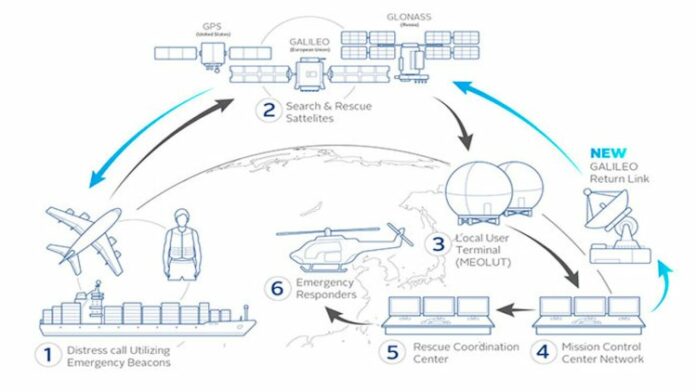Galileo is the European Union’s Global Navigation Satellite System (GNSS) constellation, which reached its operational phase in 2017, allowing technology with a Galileo-enabled receiver to use signals provided by Galileo’s global satellite constellation for positioning, navigation and timing.
Galileo’s development is part of the EU’s preparations for upgrading the international distress beacon locating organisation COSPAS SARSAT’s Search and Rescue (SAR) Ecosystem under the MEOSAR program, which requires new earth based antenna and a network of 72 SAR satellites, made up of the US GPS, EU Galileo and Russian Glonass constellations.
Galileo’s immediate impact on Search and rescue (SAR) has been the addition of 26 new satellites, allowing greater global coverage, with faster detection of the 406MHz distress frequency. Coupled with Galileo’s precision GNSS capabilities, SAR beacons with Galileo receiver’s location detection is greatly accelerated. Interaction with the GPS network has also created a Canyon Effect capability that allows signal detection in areas with previously limited coverage.
The Second major impact will be the Return Link Service (RLS), a re-assurance signal back to a new generation of SAR beacons to inform the user that their distress signal and location have been detected. This new capability is unique to the Galileo satellites and is due to be activated in early 2020.
The confirmation signal for ReturnLink will be the activation of a blue light on a new range of beacons as the blue light is widely seen as being associated with the emergency services. The flashing blue light is sent around 15minutes after confirmation that the distress signal has been detected and the beacons location independently located.
The Galileo Return Link Service Provider based at CNES headquarters in Toulouse, where the Cospas-Sarsat French Mission Control Centre is also operated. This facility is in charge of the management of the Return Link Messages and their coordination with the Cospas-Sarsat network and with the Galileo Ground Mission Segment on the transmission of messages to the distress beacons through the Galileo E1 signal.
The SAR community have long known the survival impact of dealing with a distress situation on your own, either as a solo adventurer or as a group that feels isolated due to lack of communication with the outside world. Knowing that others are aware of your situation can greatly improve your mental strength for the challenges you are facing. Return Links reassurance signal will also reduce the chances of rash decisions taken by those who feel they have nothing to lose, like leaving the site of an accident or attempting to swim to safety. Knowing that SAR professionals know your situation and location will be an invaluable support. From a technical perspective the two-way interaction of the beacon helps reassure users, often unfamiliar with the technology, that it’s activated and doing what it needs to do.
A new type of lifesaving distress beacon, the FastFind ReturnLink PLB, utilises unique functionality generated by Galileo satellite constellations Return Link Service to send a signal back to the FastFind ReturnLink beacon confirming the users 406MHz distress alert has been received and Galileo GNSS location coordinates have been detected.
Orolia Maritime will launch the new FastFind ReturnLink PLB at Mets 2019 but the unit will only be available to purchase when Galileo confirm that the system is fully operational, which is expected in late 2019 or early 2020.
The RLS feature is already available as an option in Orolia’s latest aviation ELT, the Kannad ULTIMA-S and will also be released later in 2020 as an EPIRB with an updated version of Orolia Maritime’s unique SmartFind & SafePro AIS range.
Galileo’s RLS functionality will be available to any beacon manufacturer that update their design to incorporate the necessary hardware. However, only Orolia has the history of supporting the development of the MEOSAR ground and space infrastructure, Galileo satellite timing components and leadership of the EU’s Helios project to support development of the next generation of SAR beacons to utilise the benefits of Galileo.



